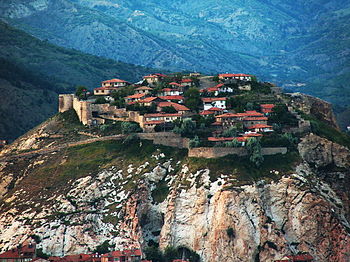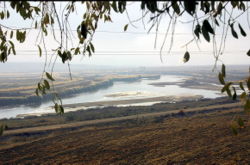- İskilip
-
İskilip is a district of Çorum Province of Turkey, on the left bank of the River Kızılırmak, located at 56 km from the city of Çorum, 100 miles (160 km) northeast of Ankara and 60 miles (100 km) southeast of Kastamonu. It covers an area of 1,187 km², and the elevation is 2460 ft (750 m). Population is about 39,124 of which 20,660 live in the town of İskilip (as of 2010). The mayor is Numan Sezer (AKP).
Contents
Etymology
Former names included Iskila (the name given to the area right back in Hittite times, Asklepios (Aesculapius) (in ancient Greek), Blocium / Bloacium, İmad, Iskelib, İskelib (the ancient name being restored in the Seljuk Turkish era) and Direklibel.
Geography
İskilip lies on a well-watered plain, several miles off the road between Çankırı and Amasya among wooded hills, at the foot of a limestone rock crowned by the ruins of an ancient fortress now filled with houses. Near the town are saline springs, from which salt is extracted. The climate is dry. The highest point is Mount Teke (1700m). The local economy depends on agriculture, especially grains and pulses, and forestry. Iskilip lies on the North Anatolian geological fault line.
History
People have been attracted to the saline springs of İskilip since the earliest times, and the town stands on a route through the mountains to the Black Sea coast. Therefore this is one of the longest-settled areas of Anatolia; copper was smelted here in ancient times, when the plain was settled by the Hittite and Hatti civilisations (from 3000 BC onwards). Rock carvings on the hill of Yivlik are said to date back to the Hittite period.
The Hatti city was then possessed by Paphlagonian kings (from 900-700 BC}, was mentioned in the Iliad and was visited by Herodotus. Then came Galatians and the kings of Pontus, but these were soon displaced by a much stronger civilisation. For the Ancient Romans, who paid their soldiers in salt, the area had great importance. Romans and the subsequent Byzantines settled here for a thousand years, making İskilip one of their key strongholds on the Kızılırmak. Byzantine rule of Anatolia ended in 1071 following their defeat by the Seljuk Turks at the battle of Malazgirt and İskilip was soon settled (1074) by the Danishmend Turks, who brought Islam to the region. Centuries of fighting ensued between further Turkish clans, and from the 13th century waves of Mongol and Tatar invaders.
In 1390 the Ottoman Sultan Bayezid I moved against the Turkish lords that by now were in control of this corner of Anatolia, with the aid of Mongol armies. After severe fighting in which an Ottoman prince was killed and the castles of Ankara, Kalecik and others were besieged Bayezid (the Thunderbolt) prevailed and the area was brought under Ottoman control. But the castle of İskilip had been seriously damaged and most of the population dispersed during the fighting, never to return. Perhaps wisely as the area was soon (1402) the scene of even more terrible warfare between Bayezid's Ottomans and the Tatars of Timur. Following the Ottoman Interregnum rule was restored by Bayezid's son Mehmed I, but İskilip's misfortune persisted, with destruction returning in a large earthquake known as the little Armageddon in 1509.
At some stage it must have recovered as by the 17th century Evliya Çelebi recorded a fortified town of 150 households and in 1849 the French traveller Vital Cuinet recorded a city of 2,000 homes with a population of 10,563 predominantly Muslims. There were 108 mosques, 6 dervish lodges, 6 koran schools, a civic building, 5 libraries, a market of 510 shops, 2 caravanserais, 4 Turkish baths, 18 fountains, a water garden, 18 tanneries, 63 flour mills, 6 bakeries, 10 coffee houses, a courthouse, a tax office, post, telegraph and a census bureau. The garden of the area were used to grow buckthorn for making natural dye-stuff.
Thus we can see that the town has had a predominantly Turkish population since the 13th century at least and the people of İskilip even today are said to speak Turkish with an accent that is the closest in modern Turkey to the language spoken by those first immigrants from the Central Asian heartland. In the early days of the Turkish Republic linguists from the Turkish Language Institute carried out research in İskilip as part of their program to bring more authentic Turkish vocabulary into the language.
Not being able to sustain the manufacturing or large-scale trade that fuels a modern city, from the late 19th century onwards İskilip has declined, and is now eclipsed by nearby Çorum, (much to the resentment of the people of İskilip, who will buy cars with Ankara license plates rather than Çorum and will go to great lengths to avoid visiting the provincial capital). The first bridge over the Kızılırmak was built, from wood, in 1930 in order to connect İskilip with Çorum. The first school in İskilip was opened in 1935, and the first high school in 1968.
İskilip today
Modern İskilip is a small town providing the surrounding area with schools and other amenities. The cuisine is typical of much of Anatolia, including a particularly renowned rice-based dolma, wheat soup keshkek, fruit syrup (pekmez), a dry egg-noodle erişte, spice-cured beef pastırma, roasted chick peas leblebi, a round loaf called Okkalık and of course there is a local kebab, in this case an oven-casserole of meat and vegetables.
Notable natives
- İskilipli Atıf Hoca - (d 1926) Islamic scholar executed in the early days of the Turkish Republic for his opposition to the banning of the fez and other symbolic headgear.
- İsmail Beşikçi (b 1939) Sociologist, historian and writer, although from a conservative family in İskilip has written on issues including Kurdish nationalism, the founding of the republic and the period of a one-party state.
- Professor Abdulhaluk Mehmet Çay - Historian and Turkish nationalist politician, former government minister and member of the Nationalist Movement Party (MHP).
External links
 İskilip in Çorum Province (in the Black Sea region) of Turkey
İskilip in Çorum Province (in the Black Sea region) of TurkeyUrban districts 
Rural districts RegionsAegean Black Sea Central Anatolia Eastern Anatolia Marmara Mediterranean Southeastern Anatolia Categories:- Districts of Çorum
- Black Sea Region
- Populated places in Çorum Province
Wikimedia Foundation. 2010.



